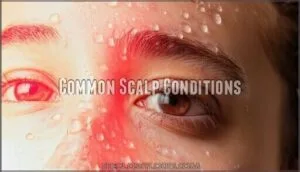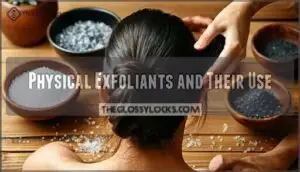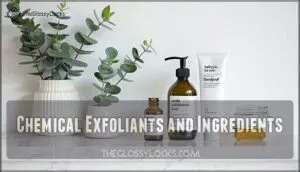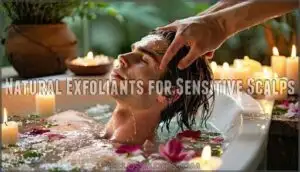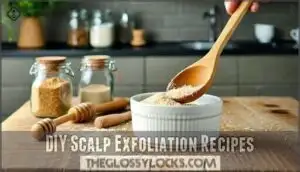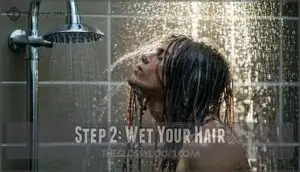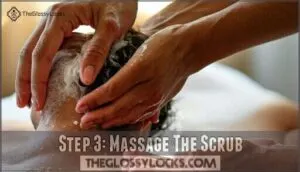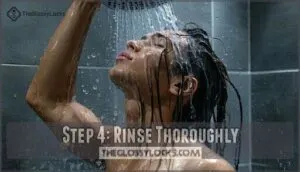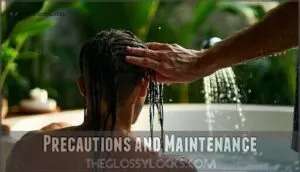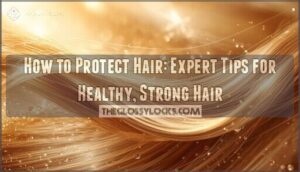This site is supported by our readers. We may earn a commission, at no cost to you, if you purchase through links.
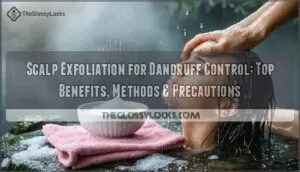
Exfoliating your scalp once or twice a week can help reduce dandruff flare-ups and promote healthier hair growth.
By removing dead skin cells and product buildup, you’ll enhance scalp cleanliness and improve hair volume and shine.
It’s all about finding the right balance, so you don’t over-exfoliate.
Now, let’s get into the details of how to make scalp exfoliation a part of your hair care routine, and what benefits you can expect to see, including improved hair volume and shine.
Table Of Contents
- Key Takeaways
- Benefits of Scalp Exfoliation
- Common Scalp Conditions
- Exfoliation Methods and Tools
- How to Exfoliate Your Scalp
- Precautions and Maintenance
- Frequently Asked Questions (FAQs)
- Should I exfoliate my scalp if I have dandruff?
- How do I get rid of dandruff build up on my scalp?
- What exfoliators break up the buildup on the scalp?
- Do dermatologists recommend scalp exfoliation?
- Can exfoliation help with itchiness always?
- How often should I exfoliate oily scalp?
- Does exfoliation work for all hair types?
- Can I use body scrub on my scalp?
- Is daily exfoliation bad for my scalp?
- Conclusion
Key Takeaways
- You’ll reduce dandruff flare-ups and promote healthier hair growth by exfoliating your scalp once or twice a week.
- It’s crucial to choose the right exfoliant for your scalp, considering your skin type and sensitivity, to avoid irritation and damage.
- You should be gentle when exfoliating, massaging the scrub into your scalp with circular motions, and rinse thoroughly to remove dead skin cells and product buildup.
- Don’t overdo it – limiting exfoliation to once or twice weekly will help prevent irritation, dryness, and potential hair damage, ensuring you get the most out of scalp exfoliation for dandruff control.
Benefits of Scalp Exfoliation
When you exfoliate your scalp, you help remove dead skin cells, excess oil, and product buildup that can trigger dandruff and irritation.
Exfoliating your scalp boosts hair growth and reduces dandruff
This simple step supports a cleaner scalp, encourages healthier hair growth, and keeps your hair looking fuller and shinier.
Reduces Dandruff Flare Ups
Every so often, your scalp sends distress flares—white flakes, itchiness, and frustration.
Regular scalp exfoliation is your go-to for effective dandruff control and reducing flare ups.
It works by:
- Removing dead skin and buildup for better scalp health
- Preventing that itchy scalp feeling
- Supercharging your hair renewal and antidandruff treatments
Consistency keeps flakes at bay!
Promotes Healthier Hair Growth
Although you can’t see it, your scalp’s health makes waves under the surface.
By working scalp exfoliation for dandruff control into your routine, you wake up sluggish follicles and set the stage for hair thickness, growth stimulation, and healthy follicles.
A regular exfoliating scalp routine for dandruff supports scalp health and hair growth—consider it one of the best hair growth tips.
| Boosts Roots | Invigorates Follicles | Grows Confidence |
|---|---|---|
| Fuller hair | Thicker strands | Strong starts |
| Clears path | Energizes scalp | Visible results |
| Reduces buildup | Encourages growth | Lasting volume |
| Stimulates blood flow | Revives roots | Better styling |
| Reboots growth | Nourishes scalp | Lively locks |
Enhances Scalp Cleanliness
Think of a clean scalp like a fresh canvas—ready for anything.
Scalp exfoliation acts as a Scalp Detox, ridding your hair follicles of dead skin, product buildup, and excess oil.
Regular scalp massage during exfoliating scalp treatments boosts scalp cleanliness and dandruff control, leaving your scalp free, refreshed, and better prepared for any antidandruff scalp care routine, which promotes a healthy scalp and dandruff control.
Improves Hair Volume and Shine
Once your scalp feels cleaner, you’ll notice more bounce and shine in your hair.
A regular scalp massage with exfoliating scalp treatments removes buildup, letting natural oils travel down the strands for healthy hair volume and a radiant look.
If you’re after shine boosters and want practical hair growth tips, scalp exfoliation for dandruff control has real scalp exfoliation benefits.
Common Scalp Conditions
You might notice your scalp acting up sometimes, showing signs like flaking, redness, or stubborn oiliness.
Notice your scalp acting up with flaking or redness
These common scalp conditions—not just dandruff, but also psoriasis, seborrheic dermatitis, and buildup from hair products—can impact how your hair looks and feels, so it’s important to understand what causes them and recognize their symptoms early, including signs like flaking.
Dandruff Causes and Symptoms
Want to keep flakes at bay? Tackling dandruff means knowing its triggers.
Dandruff causes range from Fungal Infections to Scalp Irritation, and the main signs are easy to spot:
- White Flakes sprinkled on your shoulders
- Flaky Skin and Itchy Scalp all day
- Oily patches where flakes gather
- Cyclical symptoms, especially in dry weather
Try scalp exfoliation for dandruff control methods. Understanding fungal colonization is key to managing dandruff effectively.
Psoriasis and Seborrheic Dermatitis
You’ll encounter psoriasis and seborrheic dermatitis, conditions causing scalp inflammation, skin lesions, and flaky patches.
Effective dermatitis treatment and dandruff prevention involve scalp exfoliation for dandruff control, reducing red plaques and promoting scalp health, which helps manage psoriasis and seborrheic dermatitis symptoms.
Understanding scalp psoriasis treatment is essential for developing an effective management plan.
Cradle Cap in Babies
You’re caring for your baby’s scalp, specifically addressing cradle cap.
- 1 gentle exfoliation
- 2 cradle cap treatment
- 3 infant dandruff
- 4 baby hair health
- 5 scalp exfoliation for dandruff, ensuring baby scalp care is prioritized.
Understanding cradle cap causes is essential for effective treatment and prevention of hair loss in babies.
Product Buildup and Its Effects
Using heavy styling products without proper cleansing creates a stubborn layer of product accumulation on your scalp.
This hair buildup traps dirt and oils, leading to scalp irritation and a persistently greasy scalp appearance.
The resulting flaky skin and clogged follicles make your hair look dull and lifeless.
Regular scalp exfoliation for dandruff control effectively tackles scalp buildup removal through targeted exfoliating scalp care and proven dandruff control techniques.
Exfoliation Methods and Tools
You have several effective options regarding exfoliating your scalp to control dandruff. The right method depends on your scalp’s sensitivity and the severity of your condition.
Physical Exfoliants and Their Use
Physical exfoliants work through friction, using scalp brushes, hair massagers, and exfoliating tools to scrub away dead skin cells and product buildup.
These gentle exfoliants include textured scalp scrubs containing sugar, sea salt, or charcoal particles.
When choosing physical exfoliants for scalp exfoliation for dandruff, select tools designed specifically for your scalp rather than harsh body scrubs to maximize scalp scrub benefits.
Effective scalp care often involves using proper scalp brushes to gently remove dead skin cells.
Chemical Exfoliants and Ingredients
Chemical exfoliants dissolve dead skin cells using acids instead of scrubbing.
Salicylic acid penetrates deep into follicles, while glycolic acid removes surface buildup effectively.
Zinc pyrithione and ketoconazole target dandruff-causing fungi directly.
Betaine salicylate offers gentler chemical exfoliation than traditional acids.
Tea tree oil provides natural antimicrobial benefits.
These ingredients work systematically to clear your scalp without physical irritation.
Regular exfoliation routines are essential for maintaining healthy skin and preventing various issues, which is a key part of using chemical exfoliants.
Natural Exfoliants for Sensitive Scalps
If you’ve got sensitive skin, natural exfoliants offer freedom from harsh chemicals.
Sugar scrubs provide gentle exfoliation without irritation. Oatmeal benefits include soothing inflammation while removing dead cells.
Aloe vera adds moisture during scalp exfoliation for dandruff control. Coconut oil softens skin before gentle exfoliation.
Tea tree offers antimicrobial properties for DIY scalp exfoliants, making natural options perfect for sensitive scalps. Using natural exfoliant products can enhance the effectiveness of these methods, providing a gentle and effective way to care for sensitive skin.
DIY Scalp Exfoliation Recipes
Create your own scalp exfoliation recipes using natural ingredients found in your kitchen.
Brown sugar scrubs mixed with coconut oil provide gentle exfoliation while moisturizing dry scalps.
Combine oatmeal with honey for sensitive skin, or blend aspirin tablets with water for chemical exfoliation.
These homemade remedies and DIY scalp exfoliants offer affordable scalp treatments that control dandruff naturally.
How to Exfoliate Your Scalp
Now you’re ready to transform your scalp care routine with a simple five-step exfoliation process.
Following these steps consistently will help you achieve ideal dandruff control while maintaining healthy hair and scalp conditions.
Step 1: Choose The Right Scrub
You’re ready to start your scalp exfoliation journey.
To begin, choose a suitable scrub from these options:
- Sugar-based scrubs
- Salt-based scrubs
- Gentle exfoliants with natural ingredients for dandruff control and a healthy scalp.
When selecting a scrub, consider using a scalp exfoliant product with exfoliant ingredients to effectively remove dead skin cells and achieve a healthy scalp.
Step 2: Wet Your Hair
Now that you’ve chosen the right scrub, it’s time to prepare your hair.
Wet your hair with warm water to soften it, making scalp exfoliation for dandruff control more effective.
This hair preparation step is key to a successful scalp scrub routine and dandruff control techniques.
Step 3: Massage The Scrub
Massage the scrub into your scalp using gentle circular motions, focusing on areas prone to dandruff.
This scalp massage helps distribute the exfoliant evenly, enhancing scrub distribution and promoting effective dandruff control in your scalp exfoliation routine.
Regular scalp exfoliation can help with scalp health benefits and is an important part of maintaining a healthy scalp.
Step 4: Rinse Thoroughly
Once you’ve worked the exfoliant into your scalp, reach for lukewarm water—too hot, and you risk irritation; too cold, and product might cling.
Let water run over your scalp for about a minute (Rinsing Duration), using your fingertips for Gentle Rinsing.
Pay extra attention to Residue Removal, ensuring your scalp care routine doesn’t leave behind anything that could spark dandruff, focusing on a thorough cleaning for optimal scalp health with lukewarm water.
Step 5: Shampoo and Condition
Every scalp tells a story, so your Shampoo Selection and Conditioner Type play leading roles.
Use an antidandruff shampoo with targeted Product Ingredients and apply it with gentle Application Technique, focusing on the roots.
When conditioning, stick to the hair length and tips, and Rinse Thoroughly—no shortcuts.
These simple shampooing tips and conditioning tips lay the groundwork for healthier hair treatment results.
Precautions and Maintenance
You’ve worked hard to improve your scalp health, but it’s important to follow the right precautions to avoid irritation or damage.
Careful maintenance, gentle techniques, and regular checks guarantee your scalp stays healthy and free from dandruff.
Over Exfoliation and Its Risks
Once you’ve mastered a scalp scrub routine, remember—too much of a good thing leads to trouble.
Over-exfoliation can spark scalp irritation, scalp redness, or scalp inflammation, making your head feel like it’s been through the wringer.
Scrubbing too often increases scalp sensitivity, causes hair damage, and invites dryness, while product overuse may worsen scalp damage.
Stick to a steady exfoliation frequency.
Sensitive Skin and Gentle Exfoliants
If your scalp feels like a drama queen after a little scrubbing, sensitive skin calls for mild exfoliation.
Go for natural ingredients, soothing recipes, and gentle tools—think soft brushes and exfoliating shampoos designed for dandruff treatment.
Always patch test first and listen to your scalp’s signals.
Stick with gentle scalp care to tame irritation while tackling buildup.
Post Exfoliation Care and Moisturizing
After exfoliating, prioritize hydration methods like oil application and leave-in treatments to maintain scalp health and support dandruff control, ensuring your scalp stays moisturized and protected.
This is essential for effective dandruff treatment and overall scalp care.
Consistent hydration mirrors the benefits of using lightweight facial moisturizers for skin, which is a key aspect of dandruff control.
Limiting Sun Exposure and Protection
After exfoliating, limit sun exposure to prevent UV damage and sun sensitivity.
Use a hat or Scalp SPF for protection, as post-exfoliation sun care is essential for maintaining scalp health and dandruff control.
Ensuring your scalp care routine promotes healthy scalp exfoliation.
Consulting a Doctor for Severe Conditions
If you experience persistent dandruff, severe itching, or scalp infections, consider consulting a doctor.
They can help with:
- Treatment options
- Hair loss prevention
- Managing psoriasis or seborrheic dermatitis, guiding you to see a dermatologist for proper care.
Frequently Asked Questions (FAQs)
Should I exfoliate my scalp if I have dandruff?
When in a pickle, exfoliating can help; you should gently exfoliate your scalp to remove dead skin cells and reduce dandruff flakes, promoting a healthier scalp environment naturally.
How do I get rid of dandruff build up on my scalp?
You can get rid of dandruff buildup by gently massaging a chemical or physical exfoliant into your scalp, then rinsing thoroughly to remove dead skin cells and flakes.
What exfoliators break up the buildup on the scalp?
You can use physical or chemical exfoliants, like sugar or salicylic acid, to break up buildup on your scalp, promoting a healthy environment for hair growth and reducing dandruff.
Do dermatologists recommend scalp exfoliation?
A million dermatologists can’t be wrong – they highly recommend scalp exfoliation to remove dead skin cells, reduce dandruff, and promote a healthy scalp, you’ll likely benefit from it.
Can exfoliation help with itchiness always?
You can find relief from itchiness through exfoliation, as it removes dead skin cells and debris, but results may vary depending on the individual’s skin type and condition.
How often should I exfoliate oily scalp?
You should exfoliate your oily scalp once or twice a week to remove buildup and maintain health, promoting a clean and balanced environment for healthy hair growth.
Does exfoliation work for all hair types?
You can exfoliate most hair types, but be gentle with fragile or damaged locks, and customize your approach based on your hair’s unique needs and texture.
Can I use body scrub on my scalp?
You shouldn’t use body scrub on your scalp, as it can be too harsh, causing irritation and damage to your hair and scalp, opt for gentle scalp-specific products instead always.
Is daily exfoliation bad for my scalp?
Yes, daily scalp exfoliation is like sandpaper on delicate skin—it’ll strip away your scalp’s natural protective barrier.
You should limit exfoliation to once or twice weekly to prevent irritation, dryness, and potential hair damage.
Conclusion
You’ll find that incorporating scalp exfoliation for dandruff control into your routine can be a game-changer.
By doing it once or twice a week, you’ll reduce dandruff flare-ups and promote healthier hair growth.
Remember, scalp exfoliation for dandruff control is key to a cleaner, healthier scalp and fabulous hair.
- https://www.hairstuff.sg/the-role-of-scalp-exfoliation-in-dandruff-treatment/
- https://blog.mapleholistics.com/blog/scalp-exfoliation/
- https://www.headandshoulders.co.in/en-in/healthy-hair-and-scalp/scalp/scalp-care-tips/how-to-exfoliate-scalp
- https://www.kerastase.com.ph/kerastase-articles-page/how-to-exfoliate-scalp-for-dandruff-prevention
- https://www.healthshots.com/beauty/hair-care/scalp-exfoliation/

